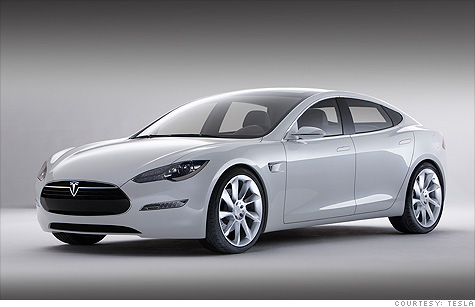
The Tesla Model S
FORTUNE -- This Saturday, Tesla Motors is holding a test drive to reveal the latest versions of its second zero-emission automobile, the all-electric four-door Model S to several thousand reservation holders. Tesla has made some extraordinary claims for the car, and analysts and investors will be watching the event closely to see if it can live up to them.
Due to go on sale in mid-2012, the seven passenger Model S is designed to do nothing less than revolutionize the auto industry. Its performance targets are extraordinary: zero to 60 miles per hour in 5.6 seconds, 120 mile-per-hour top speed, and a battery-powered range of 160 miles at minimum for the base model.
But the performance of the car itself pales in comparison with Tesla's unusual business model. Even though it lacks the engineering resources and volume efficiencies of an established automaker, Tesla (TSLA) intends to sell the car for the same as or less than competing models from larger manufacturers. Prices will start at $57,400 -- about the same as for a similar-sized Audi A6.
In order to compete at those prices, Tesla will have to stand traditional auto industry economics on its head. Consider:
Tesla believes it can overcome these shortcomings with innovations like "a holistic approach to vehicle architecture," lessons from the Roadster's "proven, road-tested technology," and "superior electric technology." Yet nothing stays proprietary for very long in a fiercely competitive industry with dozens of manufacturers and thousands of suppliers. Any genuine innovations that Tesla discovers could quickly become common property. Analysts wonder where Tesla's competitive advantage will lie.
CEO Elon Musk insists that the company will make money in 2013. One big reason, a spokesperson says, is a pair of upscale S models with extra battery capacity priced at $67,000 and $77,000 that will command gross margins of 25%. While he acknowledges the difficulty of "ramping up production by a factor of 30," Musk tells interviewers Tesla will move into the black "soon after Model S starts production."
The auto industry's harsh economics put Tesla in a bind. In order to boost production volume to reasonable levels in order to lower its overhead, it will have to cut prices. But if it cuts prices, it will shrink its profit margins. Should Tesla decide to raise prices to cover its costs, its volume will drop precipitously.
These concerns have been brushed aside by bullish securities analysts caught up in the excitement of a battery-powered car that -- if it delivers as promised -- could revolutionize the auto industry. They view Tesla as having the potential to turn the Detroit Three and create the Big Four. Their enthusiasm has been shared by the U.S. Department of Energy, which guaranteed a $465 million loan for Tesla last year and further stoked investments from Daimler and Toyota (TM).
The numbers remain daunting and Tesla needs to see some black ink soon. It lost $55.7 million in 2009, $154.3 million in 2010, and $108 million for the first six months of 2011. Some on Wall Street see Tesla making an unusually fast turnaround. Most vehicles don't recover their development costs until they are in their third year of production, but their forecasts show the Model S turning profitable within 18 months.
"The auto industry might change more in the next 10 years than the last 100," wrote veteran analyst Steve Milunovich of Bank of America Merrill Lynch in a report published August 8. "Electric vehicles (EV) represent a new category that Tesla could lead given that new entrants tend to win when disruptive technologies emerge. In our view, CEO Elon Musk may be similar to Steve Jobs in being a technology visionary also able to manage and create shareholder value."
Perhaps. Or he could turn out to be another Andy Kay, Adam Osborne, or Clive Sinclair -- pioneers in the personal computer industry who were contemporaries of Steve Jobs that fell along the wayside. ![]()